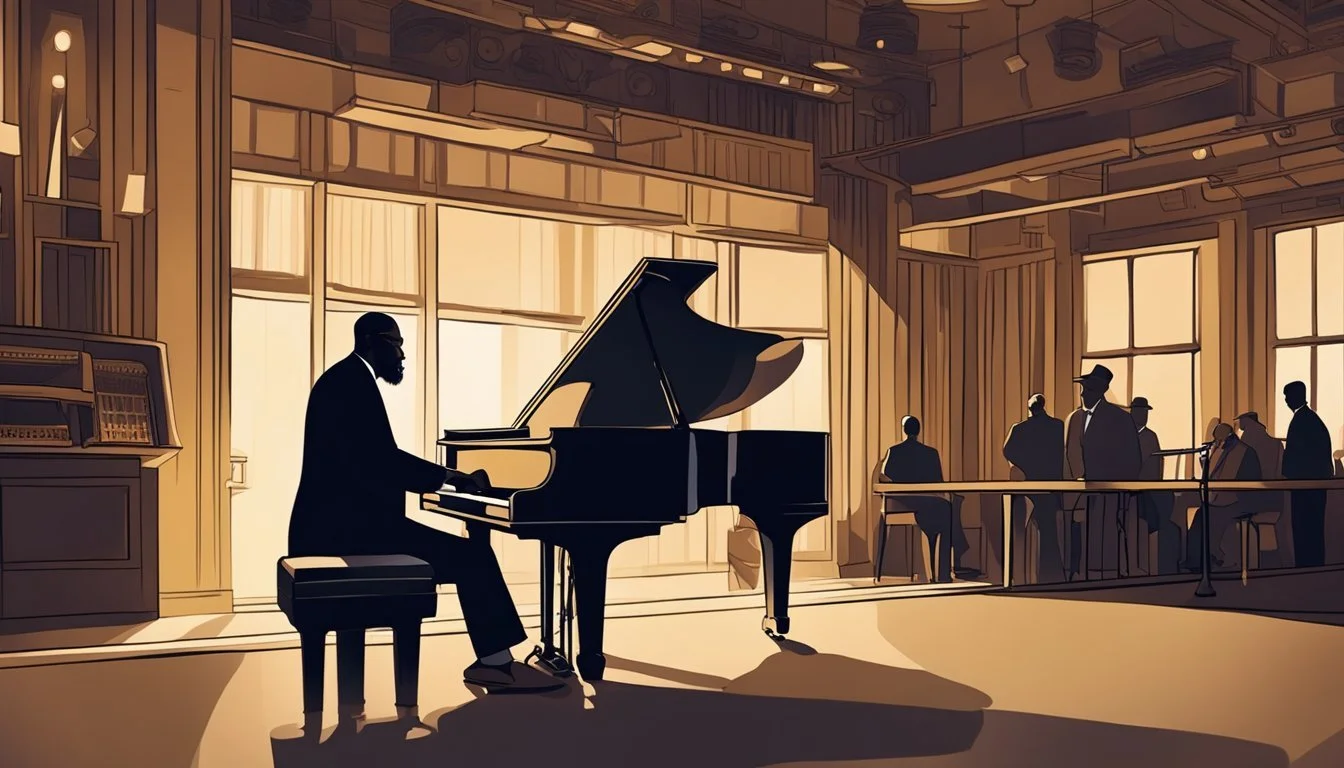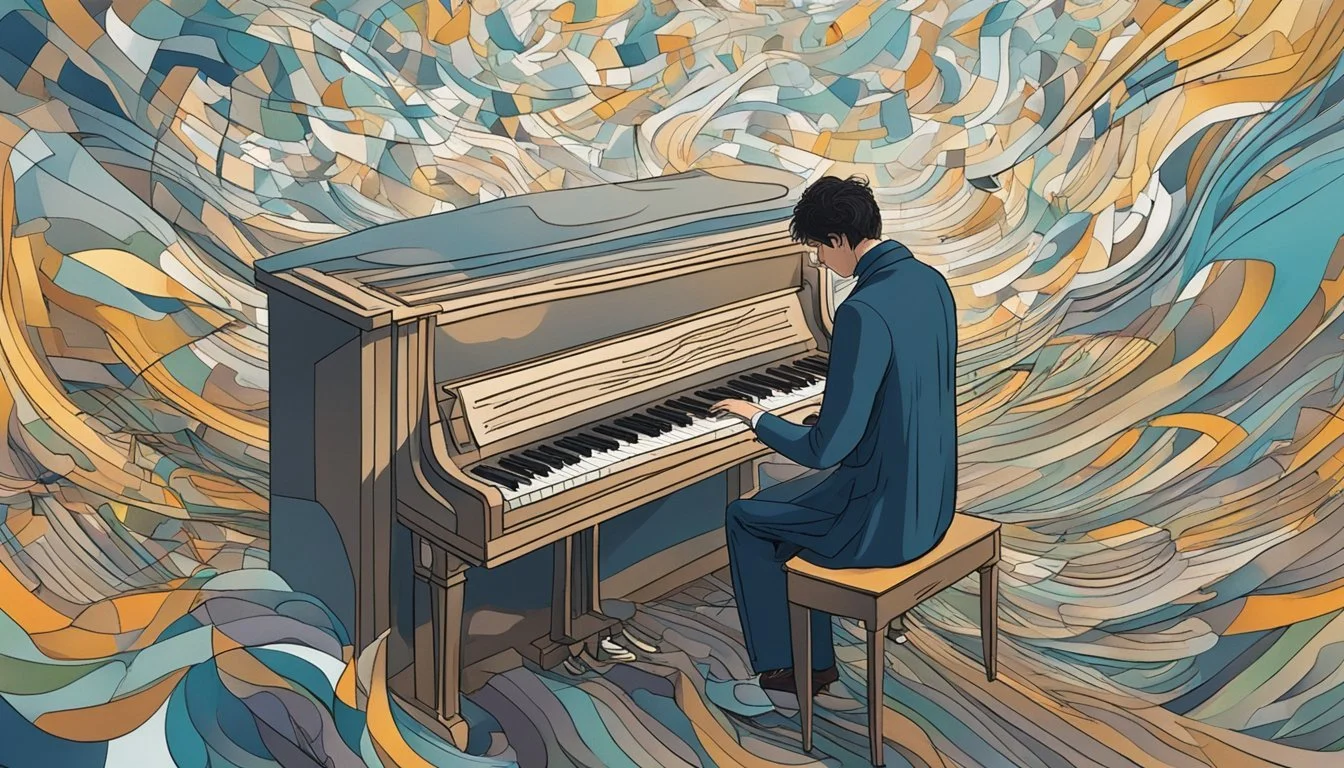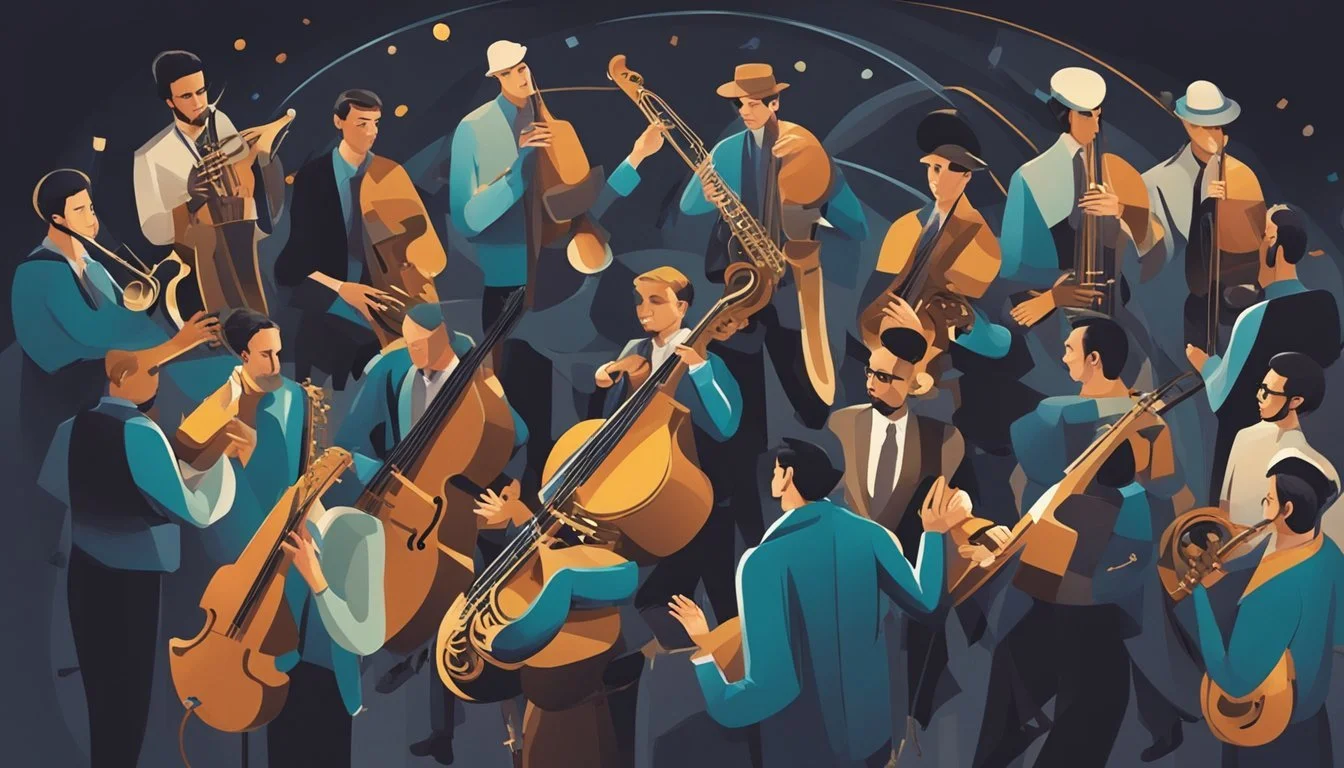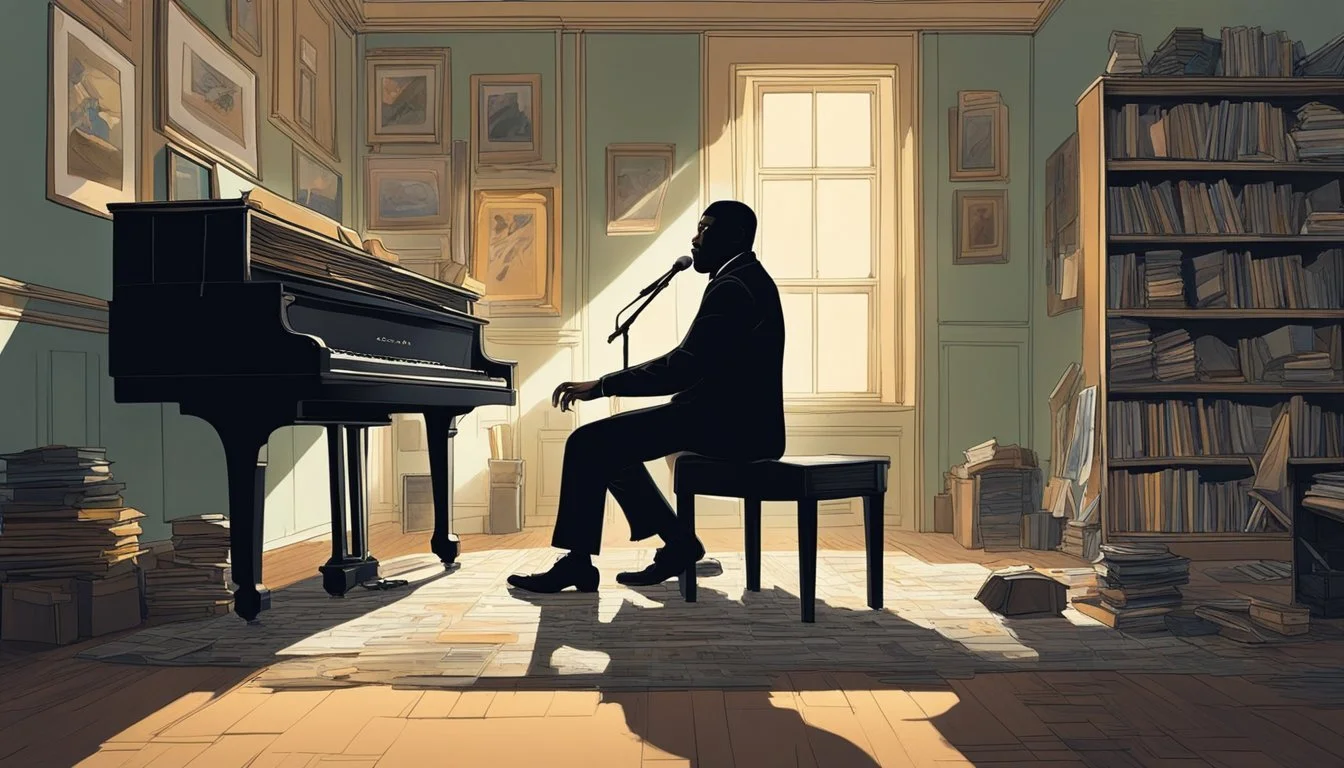Jazz and Jitters: Thelonious Monk's Battle with Depression and Bipolar Disorder
A Musical Genius's Inner Struggle
Thelonious Monk, a pioneering jazz pianist and composer, left an indelible mark on the music world with his innovative style and unique compositions. Behind the scenes, Monk grappled with significant mental health challenges that shaped his life and career.
Recent research and biographies have shed light on Monk's struggles with bipolar disorder and depression, which impacted his creative process and personal life. These conditions, often misunderstood during his lifetime, contributed to his eccentric reputation and sometimes erratic behavior.
Monk's musical genius flourished despite - or perhaps in part because of - his mental health battles. His distinctive approach to harmony and rhythm revolutionized jazz, influencing generations of musicians. The interplay between Monk's artistic brilliance and his internal struggles offers a compelling glimpse into the complex relationship between creativity and mental health in the arts.
The Life and Times of Thelonious Monk
Thelonious Monk's journey from his humble beginnings to becoming a jazz icon was marked by musical innovation and personal struggles. His unique style and compositions left an indelible mark on the world of jazz.
Early Life in San Juan Hill
Thelonious Monk was born on October 10, 1917, in Rocky Mount, North Carolina. At the age of four, his family moved to Manhattan's San Juan Hill neighborhood. This area, known for its vibrant African American culture, played a crucial role in shaping Monk's musical sensibilities.
As a child, Monk showed an early aptitude for music. He began playing the piano at age six and was largely self-taught. His sister taught him to read music, but Monk preferred to develop his own unorthodox playing style.
San Juan Hill's rich musical environment exposed young Monk to various genres, including gospel, blues, and early jazz. These influences would later inform his distinctive approach to composition and performance.
Rise to Fame in the Jazz Scene
Monk's professional career began in the early 1940s when he became the house pianist at Minton's Playhouse in Harlem. This legendary venue was a crucible for the development of bebop, a new and revolutionary jazz style.
At Minton's, Monk collaborated with other innovative musicians like Dizzy Gillespie and Charlie Parker. His unique harmonic approach and rhythmic innovations quickly gained attention in the jazz community.
Despite his growing reputation, Monk faced challenges. In 1951, he lost his cabaret card due to a drug arrest, limiting his ability to perform in New York City clubs for six years. This setback, however, didn't halt his creative output.
Influences and Musical Style
Monk's musical style was characterized by its angular melodies, dissonant harmonies, and unconventional use of silence. He drew inspiration from earlier jazz pianists like James P. Johnson and Duke Ellington, but developed a wholly original approach.
His compositions, such as "'Round Midnight" and "Straight, No Chaser," became jazz standards. Monk's playing style was equally distinctive, featuring percussive attacks and creative use of space.
Monk's influence extended beyond his music. His eccentric personality and unique fashion sense, including his signature hats, became part of his legend. Despite personal struggles, including mental health issues, Monk's contributions to jazz were monumental.
Monk's Pioneering Contributions to Jazz
Thelonious Monk revolutionized jazz through his innovative compositions, unconventional playing style, and influential collaborations. His unique approach to bebop, landmark compositions, and musical partnerships helped shape the evolution of modern jazz.
Unique Approach to Bebop
Monk's distinctive piano technique set him apart from his contemporaries. He employed dissonant harmonies, angular melodies, and unconventional rhythms that challenged traditional bebop conventions. His use of space and silence was as important as the notes he played.
Monk's percussive touch and unorthodox fingerings created a signature sound. He often played cluster chords and used the entire range of the piano to create rich textures. This approach influenced generations of jazz pianists who followed.
His improvisational style was equally innovative. Monk would deconstruct and reconstruct melodies in real-time, creating new harmonic possibilities within familiar frameworks.
Collaborations and Bebop Evolution
Monk's partnerships with other jazz legends played a crucial role in bebop's development. His work with Charlie Parker and Dizzy Gillespie in the early 1940s helped establish the foundations of the genre.
Collaborations with John Coltrane in the late 1950s produced some of jazz's most celebrated recordings. Their musical dialogue pushed both artists to new creative heights and expanded the boundaries of bebop.
Monk's mentorship of younger musicians like Sonny Rollins and Miles Davis helped spread his musical vision. These relationships ensured his influence extended far beyond his own performances and recordings.
Landmark Compositions
Monk's original compositions are now considered jazz standards. "Round Midnight," written in 1944, became his most famous work and one of the most recorded jazz compositions of all time.
Other notable pieces include:
"Straight, No Chaser"
"Blue Monk"
"Ruby, My Dear"
"Well, You Needn't"
These compositions showcased Monk's gift for crafting memorable melodies with complex harmonic structures. His use of dissonance and unexpected rhythmic shifts gave his music a distinctly modern edge.
"Brilliant Corners" (1956) and "Monk's Music" (1957) are landmark albums that solidified his reputation as a composer of the highest order. These recordings demonstrated the full range of his musical vision and originality.
Battles with Mental Illness
Thelonious Monk faced significant challenges with mental health throughout his life and career. His struggles impacted both his public image and musical output in profound ways.
Diagnosis and Public Perception
Monk was believed to have bipolar disorder, though this diagnosis came later in his life. In the 1950s and 1960s, jazz journalists often misinterpreted his symptoms as eccentricity or drug use. The stigma surrounding mental illness in that era meant many didn't understand Monk's behavior.
His erratic moods and unconventional mannerisms fueled rumors and speculation. Some viewed him as difficult or unreliable. Others romanticized his condition as part of his artistic genius.
Impact on Career and Creativity
Monk's mental health struggles significantly affected his professional life. During manic phases, he experienced bursts of creativity and energy. These periods often resulted in prolific composing and innovative performances.
Depressive episodes, however, led to canceled gigs and periods of isolation. His unpredictable behavior sometimes strained relationships with bandmates and club owners.
Despite these challenges, Monk's unique musical style flourished. Many argue his distinct approach to rhythm and harmony was intrinsically linked to his mental state.
Treatment and Medications
In the 1960s, Monk began receiving more formal treatment for his condition. He was prescribed Thorazine, an antipsychotic medication commonly used at the time. The drug had mixed effects on his well-being and musical abilities.
Later, Monk also received lithium treatment, which became a standard for bipolar disorder. These medications helped stabilize his moods but sometimes dampened his creative spark.
Hospitalization became necessary during severe episodes. These stays provided respite but also interrupted his career momentum. The balance between managing symptoms and maintaining artistic output remained an ongoing challenge for Monk throughout his life.
The Interplay Between Eccentricity and Genius
Thelonious Monk's unique personality and musical brilliance were deeply intertwined. His eccentricities often overshadowed his genius, yet they were an integral part of his artistic expression.
Artistic Temperament
Monk's creative process was marked by intense focus and unpredictability. He would spend hours at the piano, experimenting with rhythms and harmonies. His compositions often emerged from these marathon sessions.
Monk's bipolar disorder likely influenced his artistic output. During manic phases, he exhibited heightened creativity and energy. These periods sometimes resulted in groundbreaking musical ideas.
His mood swings affected his performances as well. Audiences never knew if they would witness a brilliant, inspired set or an erratic, disjointed one.
Personality and Public Image
Monk's behavior often puzzled observers. He was known for sudden silences and unexpected outbursts. These traits contributed to his reputation as an "American original."
His unconventional demeanor sometimes overshadowed his musical contributions. Jazz critics of the 1950s and 1960s often focused on his eccentricities rather than his compositions.
Robin D.G. Kelley's biography shed light on Monk's struggles with mental illness. This work helped reframe public perception of Monk's behavior.
Monk's Eccentricities
Monk's strange hats became his trademark. He wore an array of unique headgear, from berets to fur hats. These accessories added to his mystique and visual appeal.
His physical movements were distinctive. Monk would often stand up and dance during performances, even when others were soloing.
He had a habit of speaking in riddles and cryptic phrases. This quirk sometimes frustrated collaborators but also added to his enigmatic persona.
Monk's eccentricities extended to his musical approach. He used unorthodox fingerings and incorporated deliberate "mistakes" into his playing.
Monk's Circle: Family and Musical Community
Thelonious Monk's musical genius was deeply intertwined with his family and the vibrant jazz community of his time. These relationships provided both inspiration and support throughout his career.
Influence of Family on Monk's Music
Monk's family played a crucial role in shaping his musical journey. His wife, Nellie Monk, was a constant source of support and stability. She managed his career and helped him navigate the challenges of the music industry. Their son, T.S. Monk, followed in his father's footsteps as a drummer and later became a guardian of Monk's musical legacy.
Nellie's influence extended beyond the practical aspects of Monk's career. Her presence often inspired his compositions, with several pieces dedicated to her. The Monk family home in New York City became a hub for musicians, fostering creativity and collaboration.
Collaboration with Jazz Greats
Monk's musical circle included some of the most influential figures in jazz history. He formed lasting partnerships with artists like John Coltrane, Miles Davis, and Coleman Hawkins. These collaborations produced groundbreaking recordings and live performances that pushed the boundaries of jazz.
Coltrane's time with Monk in 1957 was particularly significant, helping to shape Coltrane's musical direction. Miles Davis, though sometimes at odds with Monk's unconventional style, recognized his genius and included him in recording sessions. Coleman Hawkins, an early supporter, gave Monk some of his first recording opportunities.
These relationships were not just professional. Many of Monk's collaborators became close friends, creating a supportive community that sustained him through the ups and downs of his career and personal life.
The Legacy and Influence of Thelonious Monk
Thelonious Monk's impact on jazz and American music continues to resonate decades after his passing. His innovative compositions and distinctive piano style have left an indelible mark on musicians across generations.
Posthumous Recognition
Monk's genius received widespread acclaim after his death in 1982. Time Magazine featured him on its cover, solidifying his place in American history. His album "Monk's Dream," released in 1963, became his best-selling record during his lifetime.
Columbia Records posthumously released live recordings, including "Live at the It Club" in 1982. These releases introduced new audiences to Monk's revolutionary sound and improvisational skills.
Several jazz institutions and festivals now bear Monk's name, honoring his contributions to the genre. The Thelonious Monk Institute of Jazz, founded in 1986, promotes jazz education and preserves Monk's musical legacy.
Influence on Modern Jazz and Musicians
Monk's unconventional approach to harmony and rhythm continues to inspire contemporary jazz artists. His compositions, like "I Mean You," remain staples in jazz repertoires worldwide.
Many modern pianists cite Monk as a primary influence, adopting elements of his percussive style and use of dissonance. Jazz educators often use Monk's works to teach improvisation and composition techniques.
Monk's emphasis on space and silence in music has influenced not only jazz but also other genres. His unique phrasing and timing have been studied and emulated by musicians across various styles.
Continued Relevance in American Music
Monk's music remains a vital part of American cultural heritage. His compositions are regularly performed in jazz clubs, concert halls, and music schools across the country.
Documentaries and biographies continue to explore Monk's life and artistry, introducing new generations to his innovative spirit. His image and music are frequently used in popular media, keeping his legacy alive in the public consciousness.
Monk's approach to jazz as an art form rather than mere entertainment has influenced how jazz is perceived and presented. His work continues to challenge and inspire musicians and listeners alike, cementing his place as a pivotal figure in American music history.
Cultural and Social Context
Thelonious Monk's artistry emerged within a complex social landscape shaped by racism, artistic innovation, and the quest for Black liberation. His music reflected and challenged the societal norms of mid-20th century America.
Monk within the Context of American Racism
Monk's career unfolded against a backdrop of systemic racism in the United States. As a Black musician, he faced discrimination in venues, recording contracts, and media representation.
Despite these obstacles, Monk persevered and gained recognition for his unique style. His unconventional approach to jazz challenged not only musical norms but also racial stereotypes.
Monk's experiences in New York City, particularly in jazz hotspots like Harlem and Greenwich Village, shaped his artistic vision. These communities provided spaces for Black artists to experiment and express themselves freely.
Jazz as an Expression of Black Radical Imagination
Jazz became a powerful medium for Black artists to articulate their experiences and aspirations. Monk's innovative compositions and improvisational techniques embodied the spirit of Black radical imagination.
His music pushed boundaries and questioned established norms, mirroring broader social movements of the time. Monk's avant-garde approach resonated with the growing civil rights movement and the push for social change.
Through jazz, Monk and his contemporaries created sonic landscapes that envisioned freedom and equality. Their music fostered a sense of community and collective identity among Black Americans.
Monk's contributions to jazz extended beyond entertainment, serving as a form of cultural resistance and a celebration of Black creativity in the face of oppression.
The Musical Innovations of Thelonious Monk
Thelonious Monk revolutionized jazz with his unique approach to harmony, rhythm, and piano technique. His compositions and playing style pushed the boundaries of traditional jazz, influencing generations of musicians.
Harmonic Innovations and Use of Dissonance
Monk's harmonic innovations were marked by his bold use of dissonance and unconventional chord voicings. He frequently employed cluster chords, incorporating multiple adjacent notes to create tension and complexity. In compositions like "Straight, No Chaser," Monk used angular melodies and unexpected harmonic shifts to challenge listeners' expectations.
His use of dissonance was not random but carefully calculated to create a distinctive sound. Monk often favored the tritone, an interval traditionally avoided in Western music. This approach added a sense of unresolved tension to his pieces, keeping audiences on edge and engaged.
Rhythmic Complexity and Stride Piano
Monk's rhythmic innovations were equally groundbreaking. He incorporated elements of stride piano, a style characterized by a steady left-hand rhythm, into his more modern compositions. "Rhythm-A-Ning" showcases his ability to blend traditional and contemporary techniques.
In "Little Rootie Tootie," Monk demonstrated his mastery of complex rhythms. He often employed unusual accents and syncopations, creating a sense of unpredictability in his playing. His use of space was also innovative, with strategic pauses becoming as important as the notes themselves.
Monk's percussive touch on the piano added another layer to his rhythmic approach. He would often strike the keys with a flat-fingered technique, producing a unique timbre that became part of his signature sound.
Conclusion
Thelonious Monk's legacy as a jazz pioneer remains undiminished by his struggles with mental health. His musical vision and innovative style reshaped the landscape of jazz music in profound ways.
Monk's experience with bipolar disorder colored his creative process and public persona. Yet it did not define him or limit his artistic achievements. His compositions like "Round Midnight" continue to be celebrated jazz standards.
The complexity of Monk's character - both musically and personally - has fascinated fans and scholars for decades. Recent biographical works have shed new light on his mental health challenges while affirming his status as an American original.
Monk's story highlights the intersections between artistic genius and psychological turbulence. It prompts reflection on how mental health issues impact creative individuals and their work.
Ultimately, Thelonious Monk's musical legacy transcends attempts to neatly categorize or explain his behavior. His revolutionary approach to harmony, rhythm, and improvisation continues to influence jazz musicians today.








